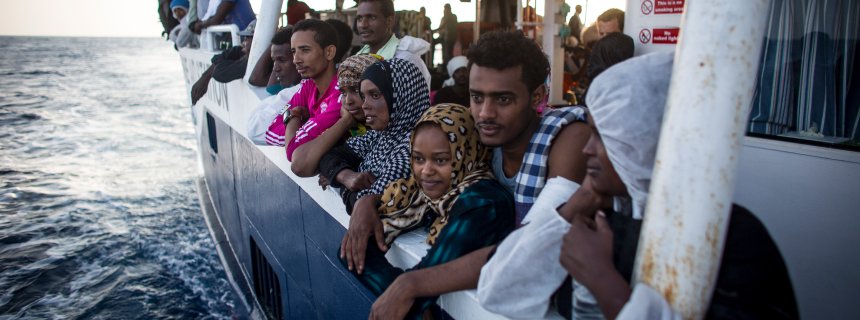Mediterranean Desperation: Saving Lives at the World’s Most Dangerous Border
IN FOCUS, 17 Aug 2015
Juliane von Mittelstaedt and Christian Werner (Photography) – Der Spiegel
Doctors Without Borders is the only major humanitarian organization actively rescuing refugees in the Mediterranean. So far, it has saved more than 10,000 people. But in the world’s biggest crisis region, timing is everything.
13 Aug 2015 – The call comes in at 10:15 a.m. on the fourth day at sea, just as the ship’s captain says it looks like it’ll be a quiet day. A refugee boat has been spotted at 33 degrees 05 minutes north latitude and 12 degrees 27 minutes east longitude, 17 nautical miles off the coast of Sabratha, Libya. It could be a rubber dinghy, with space for around 100 people. Or it might be a wooden boat, with up to 800 people on board. The captain hits the throttle, pushing the MY Phoenix to full speed.
It’s the law of the sea: With every passing hour, the children on board the refugee boat get weaker, more women faint, the men below decks inhale more toxic gasoline fumes, the inflatable dinghies lose air and the wooden boats take on more water. Every hour increases the danger of the boats springing a leak or simply sinking.
And the rescue workers won’t reach the troubled vessel for another three hours.
On board the MY Phoenix, preparations begin. There’s Regina Catrambone, an Italian woman who founded the “Migrant Offshore Aid Station,” or MOAS for short. There’s also the emergency relief coordinator Will Turner from Great Britain and the American nurse Mary Jo Frawley, both of whom work for the aid organization Doctors Without Borders. These three people are the heart of the mission, but of course they are not alone. With them are a captain from Spain, a drone pilot from Austria and a rescue specialist from Malta. Altogether, there are 18 of them, patrollingg the waters between Sicily, Malta and Libya — an area almost the size of Germany. They wait, sometimes for a call from Rome, other times for a dot to appear on the horizon.
The 40-meter-long MY Phoenix was a fishing trawler before it was retro-fitted as a research vessel. Now, in its third life, it sails on behalf of humanity with one simple goal: to save lives where no one else does. It is a floating refugee camp, equipped with an infirmary full of pain medication alongside drugs to combat seasickness and scabies. It also has an ample supply of baby food and oxygen, a cooler with vaccines and 50 body bags in two sizes: one for adults and one for children.
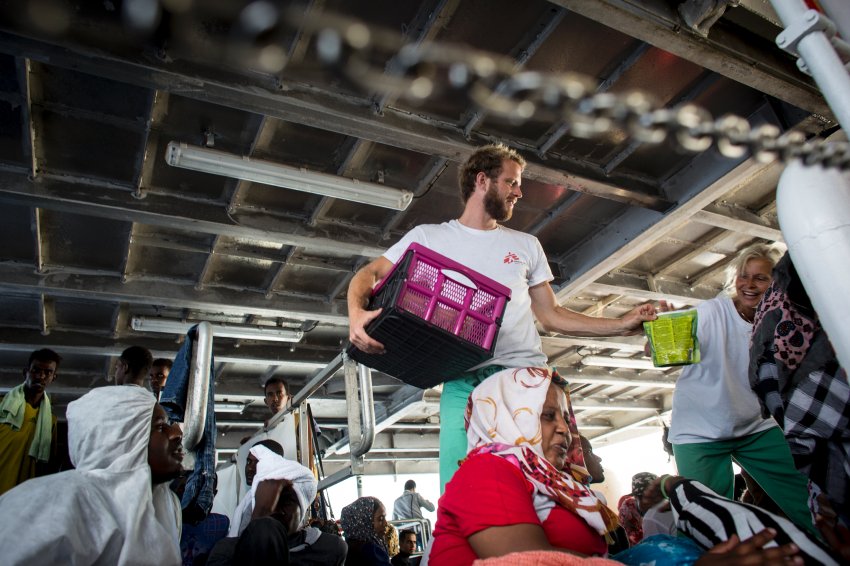
Will Turner and Mary Jo Frawler, two workers on board the Phoenix, hand out warm meals — called “Adventure Food” — to the newly rescued refugees. Most of the people on board have little more than a plastic bag with all of their possessions inside. They are dehydrated, hungry and exhausted from the hours spent onboard a flimsy wooden boat before being picked up.
The Mediterranean has become a crisis region, one where more than 2,000 people have died this year already — more than have lost their lives in attacks in Afghanistan. But of course that figure is misleading. It reflects only the number of recorded deaths. Who knows how many people have drowned without a trace?
Nevertheless, no aid agencies are active in the region. They all wait on shore for the survivors to arrive. The business of saving lives is left to those who are the least prepared: navies and merchant vessels. Meanwhile, more and more refugees are embarking on the perilous journey across the Mediterranean — 188,000 so far this year.
It’s hard to believe that a crisis area of this magnitude is empty of aid workers — unthinkable, Doctors Without Borders thought, or, as their founders call them, Médecins Sans Frontières, MSF. It is the biggest, best organized medical relief organization in the world. An army of survival. They are professionals for natural catastrophes and civil wars, and they are engaged in the fight against HIV, Ebola and measles. With a budget of €1.066 billion ($1.16 billion) in 2014, MSF’s 2,769 international employees and 31,000 local helpers undertook some 8.3 million treatments.
The World’s Deadliest Border
They calculate the need for help based on mortality rates — a cold, precise measurement. An emergency situation is considered acute when there is one death per day for every 10,000 people. Last year, at least 3,500 refugees died in the Mediterranean while 219,000 made it to Europe. That’s a mortality rate of around 10 per day, or one in 63.
MSF, until now a land-based operation, has decided to set sail. Never has the organization’s name been more fitting than right now, as it carries out its mission in a vast sea that has developed into the world’s deadliest border.
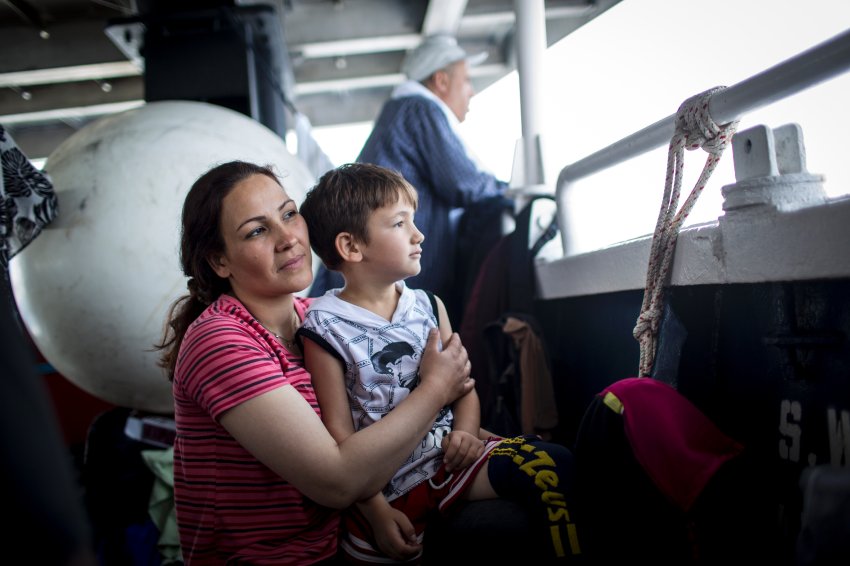
Aboard the Phoenix, one thing is clear: No one flees their home country without a good reason. One Syrian woman, Namat, seen here in the pink shirt, fled with her son in search of a better life in Europe. She left her husband and daughter behind. The plan is for Namat to reach Germany and then have the rest of her family join her. Namat treats her escape from Syria as a vacation to keep her son Omar’s morale high. She promised Omar that he could ride a bicycle once they had safely reached Germany. “This trip is for him,” Namat says. “So that he may have a better life.”
Three boats have been in action since early summer. The Dignity 1, the Bourbon Argos and MY Phoenix, the smallest of the fleet. Together they have room for 1,400 refugees. It is the only real private rescue mission in the Mediterranean, and it is almost entirely funded by donations. Operating costs have already topped €10 million this year. Of that, Phoenix, jointly funded by MOAS, has cost €1.6 million thus far this year. MSF has rescued more than 10,000 people so far. By mid-2015, the mortality rate in the Mediterranean was one in 76. A small victory, but a victory nonetheless.
An estimated 15 to 20 boats carrying around 3,000 people set sail from Libya’s beaches every day. After a few hours, they call a contact person in Italy or they get in touch with the Maritime Rescue Coordination Centre (MRCC) in Rome directly. That’s if a navy vessel or a cargo ship doesn’t stumble across them first. Whoever is close by is obligated to come to the rescue. But what if no one is nearby to save them?
Such was the case on Wednesday last week when a fishing boat sank off the coast of Libya with 600, maybe 700 people on board. They were moments away from being rescued by an Irish naval ship when the refugees all pushed to one side of the boat. As they tried to get closer to their saviors, the boat capsized. Only 373 people survived. Everyone who had been below deck when the boat sank was dragged to the depths of the sea. The three MSF boats were there too, but not to save lives. They were there to recover bodies.
But now, the Phoenix is on its next mission. It’s 11:30 a.m. and in a darkened cabin, three employees of the Austrian firm Schiebel are sitting in front of their monitors steering a drone. It offers the first sign of the boat.
A bright fleck in a sea of blue.
It looks stable. Judging by its size, it’s bigger than a dinghy, and it sits low in the water. The fleck is also moving. That’s a good sign. It means the boat is still operable. But it is moving slowly and going in curves rather than a straight line. Maybe it is already taking on water, or maybe the man at the helm has lost his bearings.
Those on board the boat will later explain that they left at 3 a.m. Anyone who complained about the tight quarters was summarily beaten by the smugglers. Some had their money and jewelery confiscated as they embarked. Some paid only $500 for the journey, others $2,000. It didn’t take long for the helmsman to abscond. Before he left, he told the others to head toward a light in the distance. So they did, without realizing that it was a flame from the Bouri oil platform that shone over the sea like a lighthouse. They thought the light was Europe.
‘Welcome On Board’
By daybreak, there was still no sign of land. The water in the boat was rising, and the children had begun screaming. The men took turns steering, always maintaining their due-north course. They drove like this for 10 hours in their open, 15-meter-long wooden boat with the sides painted blue and a tiller that was no more than a piece of iron pipe.
Shortly before 1 p.m., the boat appeared on the horizon, coming ever closer. Some refugees huddled on deck, some hung over the sides. Many of them had towels wrapped around their heads. It’s surprising how quiet 267 people can be. The only sound came from the motor as it rattled and belched smoke.
A direct transfer onto the Phoenix would be far too dangerous. The rescuers therefore use their rubber dinghy and they slowly approach the refugee boat. “You’re safe. Stay calm!” they shout. They toss over life jackets and bring the first refugees back to the ship. The entire rescue operation takes two hours. Once on board the Phoenix, refugees are greeted with a sentence that would seem ridiculous if it weren’t meant so seriously: “Welcome on board.”
Some collapse as soon as they reach the boat plank, exhausted by the hours at sea and by days and weeks of waiting that came before. All the energy with which they had clung to life suddenly vanishes. Some pray, one Syrian blows kisses. Previous missions even saw some take selfies during the rescue operation or ask for the Wi-Fi password as soon as they were safe on board.
Some look like they are on a Sunday outing to Europe. The men sport blazers, the women wear heels and nail polish. Others are barefoot and wrapped in blankets. Most of the refugees have nothing more than a plastic bag with them, although some carry backpacks and there is even one person with a hard-shell suitcase in tow.
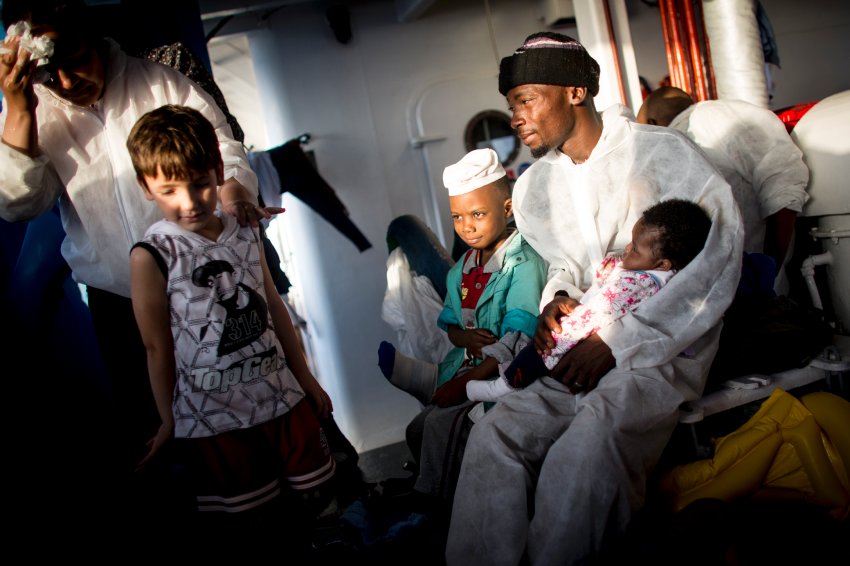
Day One after the rescue was marked by complete and utter relief. On Day Two, however, that relief was overshadowed by a sense of uncertainty as to what was in store for them. The refugees’ questions took on a new sense of urgency. They wanted to know why they couldn’t travel anywhere they wanted in Europe, and why the Europeans didn’t seem to care about what happened to them in their home countries.
By the time everyone has boarded the Phoenix, the count is 267 people, including 27 children and 30 women. All that they left behind on their boat is a few empty bottles, some children’s photos, sandals and a few Libyan coins. Below decks, there is hardly room to sit up straight. It’s hot and sticky and water can be heard sloshing under the planks. Thirty to 40 people were crowded into this space before the Phoenix showed up. A few more hours, and the space would have been full of water.
During the rescue operation, the Italian destroyer Caio Duilio approaches. A masterpiece of military engineering, the 153-meter-long ship has anti-aircraft missiles, torpedoes and artillery on board. It is a floating outpost of Fortress Europe — but it is poorly suited to rescue people. The soldiers climb onto the empty wooden boat, examining and eventually sinking it. Afterwards, the destroyer sails alongside the Phoenix for a time, a gray shadow on the horizon. This is what Phase 1 of EUNAVFOR Med, the military operation against human trafickers, looks like.
Friend and Foe
The army is simultaneously MSF’s adversary and its partner. In order to save lives, the aid workers have to do what they otherwise avoid: cooperate with the military. The Italians determine which boats are to be rescued and where the refugees are to be brought. Only then is MSF informed by the Maritime Rescue Coordination Centre in Rome about boats in distress. Only then are they allowed to bring the refugees ashore. Under the law, the refugees are still considered illegal immigrants. A ship full of refugees not permitted to dock anywhere. It would be a nightmare.
It’s Turner’s 10th rescue mission. The Brit is an emergency coordinator, making him the head of the six MSF members aboard the Phoenix. He’s also the youngest member of the team, a quiet, gentle man who, far from being a romantic, is radically pragmatic. He has worked full-time for MSF for four years on a contract renewed annually that puts him in charge of logistics and planning. His eyebrows are bleached from the sun and he has worn the same pair of sneakers for years through the world’s crisis regions, often having them patched up at whatever cobbler he could find in Africa.
He is only 32 years old and he has already seen a massacre: 13 village elders in Boguila, Central African Republic, whom he called together, were shot and killed by rebels before his eyes. Three local MSF staff were also killed. “A difficult situation,” he calls it. The only visible effect of the shock is a nervous twitch when he talks about it. The MSF clinic in Boguila had 200 beds; it was a factory of survival, but it was closed after the massacre. Ultimately, the death toll of the attack was much higher than 16.
Turner thought no mission could ever top Boguila. Then came Ebola, and he was sent to Sierra Leone to build the second-largest Ebola station in West Africa. MSF treated thousands of patients, with the hopes of the entire world resting on their shoulders. It was as if MSF had become a medical UN of sorts — just without the bureaucracy, scandals and veto powers. The world has aid workers like Turner to thank for the fact that Ebola didn’t claim even more victims.
And now the Mediterranean — “a holiday mission,” Turner calls it. Dolphins jump in the waters around him as giant turtles swim by. It’s the most beautiful workplace in the world. But it can also be the worst, such as when they’re not rescuing survivors but recovering bodies. This time around, however, they aren’t too late.
On board the Phoenix, the helpers are in high gear, handing out water, energy biscuits, socks and coveralls to keep people warm. The most frequently asked questions: Where are we? Where are we headed? Can I call my family?
The refugees will spend 48 hours on the ship before it docks in Reggio Calabria, on Italy’s southernmost tip. As evening falls, some take pictures of the sunset while others pray or lay down, placing their bags under their heads to use as pillows.
Who’s Who
The maelstrom called migration washed them all onto the decks of the Phoenix, a floating refugee camp for 10 nationalities, outfitted with a sun awning and two portable toilets. There are young men and women from Ethiopia, Somalia, Nigeria and Eritrea. Most of them are from Bangladesh — 131 in all. There are also quite a few from Sudan and Syria. There are even three Pakistanis, two Ghanaians and two Senegalese.
There’s also a family with two babies that fled Boko Haram in Nigeria. Josef, 31, from Darfur, who has lived in one refugee camp after another since his village was destroyed by Janjaweed rebels in 2005. And Eric, 21, from Ghana, who says he lost his entire family during a major fire in Accra.
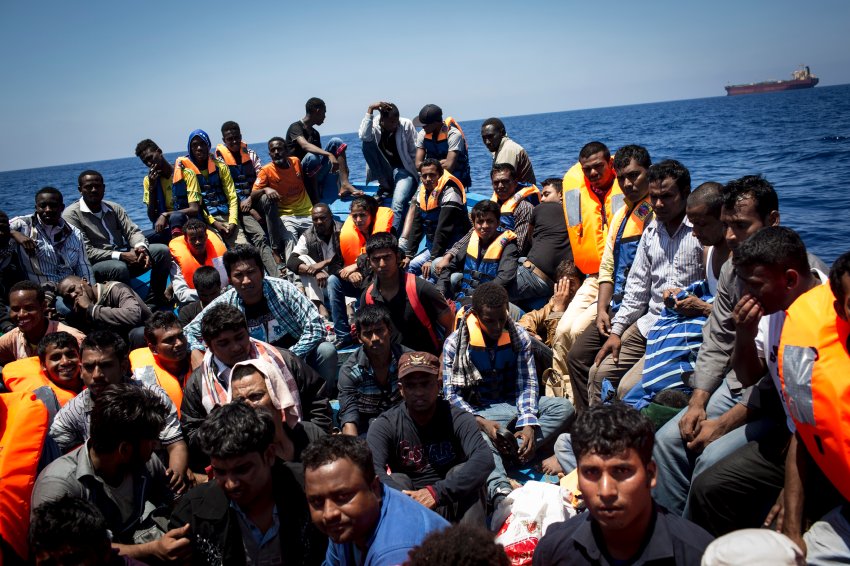
Before the Phoenix, a robust ship that once functioned as a research vessel, the 267 refugees made their way across the Mediterranean in a rickety wooden boat only 15 meters long. Some paid $500 for the journey, others $2,000. Anyone who complained about the tight quarters was summarily beaten by the smugglers.
Then there’s Aminul, 21, from Bangladesh, whose father was a farmer before being crippled by a stroke. His mother sold everything to raise the $5,000 for his journey to Tripoli. For six months, he vacuumed offices and cleaned toilets, but he hardly ever earned any money. He says that when he asked, his boss held a gun to his head and told him: Next time I’ll shoot you.
“I could not go back to Bangladesh,” Aminul says. “It was easier coming to Europe.” His life is an investment, and going back would be a total loss.
There are also the Somali teenagers Asma and Mohammed. She’s 16, he’s 18. Their story is a nightmare, one that mirrors the experiences of many other people onboard the ship. They were kidnapped in Libya, beaten with cables and fed only one piece of bread per day. They had to pay a ransom of $5,200 to free themselves. To come up with the money, their parents in Mogadishu had to take out a loan. Clinging to one another, they say: “We wanted a better life. What could we possibly become in Somalia?” They imagine a better life as him playing soccer and her becoming a doctor. “But had we known how dangerous it would be, we wouldn’t have left,” Mohammed says, showing off the scars on his back. “We had a 50-50 chance of survival. No one knew where we were. We could have simply disappeared.”
Namat, a 35-year-old elementary school teacher from Yarmouk, Syria, says her house was destroyed, so she fled to Damascus. But by this summer, her hope and savings were exhausted. The money they had, $4,000, was only enough for half the family. So she took her 5-year-old son Omar and left. Her husband and daughter stayed behind. Namat shows pictures of her 15-year-old daughter at the mall, on the playground and blowing out the candles of a birthday cake. The pictures show a happy family. It is now up to Namat to put this family back together again. Her plan is to reach Germany and then have her husband and daughter join her.
She laughs as she swipes through the photos on her smartphone. It’s a laugh against fear, a laugh for her son, to whom she has sold their escape as a vacation and whom she promised could ride a bicycle once in Germany. Omar was born shortly before the Syrian civil war. So far, his life has been made up of one exceptional situation after another. Now he stands at the ship’s side and beams at the sea, a cheerful little boy who is enjoying his vacation. His mother says: “This trip is for him, so that he may have a better life.”
A Restricted Impact
Two hundred sixty-seven refugees, 267 reasons to flee: war, oppression, poverty, tragedy and hope for a better life. One thing’s for sure: There’s no flight without plight.
The nurse Mary Jo Frawley, her hair bleached by the sun to a hue somewhere between blond and gray, perches on a camping chair next to a box of medication. The examination begins with a simple question: How are you? This question leaves some of her patients crying, but it prods most of them to talk, those who are pregnant, rape victims, the traumatized and the exhausted.
Frawley was a nurse at Long Beach Memorial Medical Center in California for 20 years. In 1999, she went on her first assignment with MSF and she never went back. Now she is 60 years old and has no plans of retiring. She says she wants to continue until she dies. Is there anything better than helping other people? Always being in a new place, discovering something new? Discovering how to live, time and again, after being so close to death?
When she tells stories, it’s like being on a tour of the crises of the past two decades: Sierra Leone, Haiti, Sudan, Syria, Somalia, Central African Republic, Zimbabwe, Sri Lanka, Chad, Pakistan. These are also countries where many of the Mediterranean refugees come from. They are ambassadors from a world of unresolved conflicts, places into which not even the bravest aid workers rarely dare go anymore. Today, MSF only operates in 63 countries. It had to reduce projects or close them altogether in Libya, Nigeria, Sudan, Mali, Somalia and Burma for security reasons or because the regimes there wouldn’t permit them to work.
Although the need is swelling and the number of conflicts rising, the room to operate for humanitarian organizations is shrinking. MSF’s annual report in 2014 was a unsparing account of instances in which the organization could and could not help. “Some 59 percent of activities were carried out in settings of instability,” it stated.
That’s why Frawley is on the Phoenix in the first place. For her, rescuing refugees is just a final link in a chain of failures. Since they can no longer help these people in their home countries, they would like to at least make their escape a bit more tolerable. There are times when she meets people from Sudan or Somalia who lived in refugee camps where she worked. MSF has even rescued people at sea who were once local MSF workers. The crises have come full circle. Although the aid workers can be deployed anywhere in the world within 24 hours, they have begun more and more projects in the last 15 years in Europe of all places. In addition to the ships, there are a total of 107 full-time helpers in Serbia, Macedonia, Italy and Greece. They have clinics and trauma care services. Sometimes they simply organize buses for the refugees, such as on the Greek island of Lesbos. After all, how can one go and rescue people abroad when there is so much to do at home?
For the newly rescued refugees, the first day aboard the Phoenix is marked by the sheer joy of being alive. It’s not until the second day that they begin to worry about what is in store for them. This is also the most difficult day for the MSF workers, because the refugees’ questions take on a new sense of urgency. Why can’t we travel anywhere we want in Europe? Why don’t you want us in Europe? How come nobody cares what happens in our home countries?
Turner, the team leader from Great Britain, hates questions like these. What’s he supposed to do? Deflate all of their hopes? Should he tell them all about reception camps, the Dublin Regulation and grounds for asylum? Should he tell them who will have a chance of staying in Europe and who will be deported or be forced to go into hiding? In the end, it’s all part of a system that he rejects himself, because he thinks Europe could accommodate many more people. What are a few hundred thousand refugees compared to the millions being taken in by Jordan and Turkey?
Instead, he tells them about Europe. He sketches a map for them of the continent they so long for. It helps them know where they are and where they’re going. He sits down and talks to them, knowing full well that listening is the best medicine he can provide.
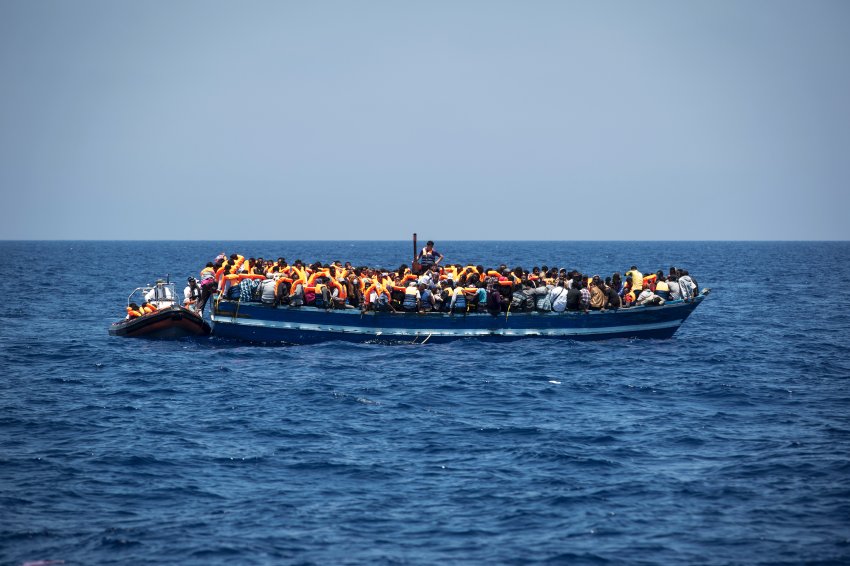
Two hundred sixty-seven refugees, 267 stories of loss and displacement, persecution and war. The refugees’ stories read like a laundry list of the major crises in Africa and the Middle East: genocide in Sudan, terror by Boko Haram in Mali and civil war in Syria, to name just a few.
The Refugee Business
The day passes and the refugees’ second night on board the Phoenix approaches. In the boat’s inner quarters, the crew is watching the movie “Castaway,” featuring Tom Hanks trying to escape from a lonely island on a raft. But Turner prefers to watch the waves outside dance in the moonlight. He thinks about a word that the German interior minister is so fond of using: pull factor. It’s a hard word for Turner to stomach because it places blame for Europe’s migrant crisis on the very people who are trying to help.
“But a Syrian fleeing Yarmouk doesn’t consider ahead of time whether he’s going to be rescued at sea or not,” Turner says. Destroying ships only makes the passage across the Mediterranean more expensive — or the boats less seaworthy. The principle of supply and demand also applies to the refugee business. It is, however, one of the bitter ironies of helping that even good intentions can have fatal consequences. The more refugees that are rescued off the coast of Europe, the greater the danger becomes that smugglers will make even less of an effort to use safe boats. The refugee crisis is as much a dilemma for the rescuers as for anyone else.
“But given the many deaths, we had no choice but to do something. If we weren’t here, more refugees would surely drown,” Turner says. “People are dying because we are guarding our borders with increasing ferocity. I can’t accept this.”
For this reason, he wishes MSF would make flight and migration its top priority and that it would urgently formulate a political position. What organization could be more qualified than this one, founded 44 years ago as the younger, wilder sister of the International Committee of the Red Cross? It’s an organization that has been awarded the Nobel Peace Prize and showered with praise.
But even within MSF, rescues at sea are controversial. The organization’s traditionalists in particular would prefer it to stick to classical medical emergencies. But is that enough in a world in which so many people — almost 60 million last year — are on the run? In a world in which conflicts don’t only leave people wounded and starving, but hopeless too? Many people no longer want to stay in refugee camps, where their only destiny is a perpetual state of vegetation. They don’t want to exist in tents and huts on the periphery of society, looked upon as victims and pitied. No, they want to take put their fates in their own hands. That’s why they set out for a better life.
In the morning, as Italy appears on the horizon, Turner gives a farewell speech: “We’d like to thank you for being such a nice, cooperative group. It was a pleasure having you with us.”
The men sweep the deck, fold the wool blankets and shine their shoes. Namat, the Syrian, powders her face and applies lipstick. Everything she owns is in a toiletry bag from Old Spice. Inside are passports, money, lipstick and makeup. The girls from Ethiopia do their hair and put on earrings. Aminul, the Bangladeshi, shaves and checks his appearance in his smartphone camera.
They’re making themselves look nice for Europe.
On the Lookout for Traffickers
But Europe shows its ugly side: a locked up pier, white tents, immigration officials, police, Health Ministry officials, paramedics, the Red Cross, photographers. People wear masks as if there was a threat of Ebola. Officials board the ship, making their way through the rows of refugees. The looks on their faces are tentative, as if to say: Which one of you is a trafficker?
Shortly thereafter, they escort three Sudanese off the ship. Maybe they steered the refugee boat, but that doesn’t make them human traffickers. The fact is, those who steer the boats are usually the poorest of them all. They pay less, and for that they get a quick briefing and a satellite phone. Italy considers such people traffickers — a charge punishable by up to 10 years in prison.
Turner stays back, clenching his jaw in anger. MSF has an agreement with the authorities that they refrain from questioning anyone on board the ship because MSF wants no part of that. But the Italians seem to care less and less about their agreement with the aid workers. They arrest at least one refugee nearly every time. Maybe there always has to be at least one arrest so that Italy can show it is taking action.
Aminul shoulders his black backpack with all his clothes inside and goes ashore. Namat and her son follow suit, smiling all the while, as if they have reached their next vacation destination. Asma, the Somali, is unsteady, trembling, dizzy and sick from all the excitement. As soon as she reaches shore, she collapses.
Turner remains on the ship. He wonders what will become of them all — the guys from Bangladesh, the Syrian war refugees, the kids from Somalia. Their first encounter will be a reception center, where they’ll be registered — or not. Then they’ll head north. No more than a week later, Namat, the Syrian, and her son will arrive at the Patrick-Henry-Village in Heidelberg, Germany, an overflowing emergency shelter already at triple capacity with 2,800 people.
Will he stay in touch with any of them? “Actually, never,” Turner says. He wants to keep his work and his private life separate. Plus, he doesn’t want to make any promises he can’t keep. He’s content with being the man who saved their lives.
And with that, the Phoenix heads back out to sea.
DISCLAIMER: The statements, views and opinions expressed in pieces republished here are solely those of the authors and do not necessarily represent those of TMS. In accordance with title 17 U.S.C. section 107, this material is distributed without profit to those who have expressed a prior interest in receiving the included information for research and educational purposes. TMS has no affiliation whatsoever with the originator of this article nor is TMS endorsed or sponsored by the originator. “GO TO ORIGINAL” links are provided as a convenience to our readers and allow for verification of authenticity. However, as originating pages are often updated by their originating host sites, the versions posted may not match the versions our readers view when clicking the “GO TO ORIGINAL” links. This site contains copyrighted material the use of which has not always been specifically authorized by the copyright owner. We are making such material available in our efforts to advance understanding of environmental, political, human rights, economic, democracy, scientific, and social justice issues, etc. We believe this constitutes a ‘fair use’ of any such copyrighted material as provided for in section 107 of the US Copyright Law. In accordance with Title 17 U.S.C. Section 107, the material on this site is distributed without profit to those who have expressed a prior interest in receiving the included information for research and educational purposes. For more information go to: http://www.law.cornell.edu/uscode/17/107.shtml. If you wish to use copyrighted material from this site for purposes of your own that go beyond ‘fair use’, you must obtain permission from the copyright owner.
